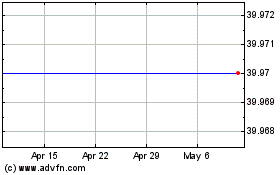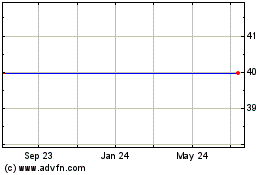Weak Stock Volume, Low Volatility Weighed On Bank Trading In 1Q
April 23 2012 - 1:03PM
Dow Jones News
NEW YORK (Dow Jones) -- To all the dramatic changes in stock
trading over the last decade that have eroded one of the
cornerstone businesses of Wall Street banks, add yet another from
the first quarter of 2012: weak volume and low volatility that
limited action in equities trading.
Despite an 8% run-up in U.S. stocks that saw the Dow climb back
above 13,000 during the period, equity volumes were 16% lower than
the prior quarter and 31% below year-ago levels, according to
NYSE-listed share-volume data. The weakness comes on top of margin
pressures that have cut commissions and spreads to just pennies per
share.
As stock trading continues to migrate to electronic execution
from human handling, the commissions banks can charge to handle
trades -- and the money they make through premiums and discounts on
asset trading -- has fallen dramatically.
"Commissions, obviously, in the equity business have gotten
smaller across the industry," said John Andrews, Citigroup's head
of investor relations. "The equity business has changed
dramatically in the last 15 years."
The low volume and volatility in the first quarter further
weighed on the business, particularly as large institutional
investors such as pension funds, scarred by the stock market
meltdown of 2008 and 2009, diversify away from equity holdings.
For the most part, revenue from equity trading at banks and
commissions at retail brokerages improved from a lackluster fourth
quarter but fell from year-ago levels. But all in all, banks appear
to have largely adapted to what is now considered a commoditized
business. Some firms held their own, others limited declines and a
couple even booked gains.
"Equities appears a bit weaker," Barclays said in an industry
assessment prior to earnings announcements over the last week,
noting that banks would show better results in trading of
fixed-income, currencies and commodities than in stocks. "We expect
equity results to be pressured as market volumes generally
declined, while reduced market volatility could weigh on derivative
results."
The call was right: Across the major banks and retail
brokerages, revenue from equity trading and brokerage commissions
fell 7% on average from year-ago levels.
Citigroup (C) and Goldman Sachs (GS) both posted declines in
equity trading revenue versus the year-ago quarter. Citi's fell 18%
to $902 million and Goldman's dropped 3% to $2.3 billion. Morgan
Stanley (MS) eked out a 5.8% gain, and J.P. Morgan (JPM) and Bank
of America (BAC) reversed year-ago losses. In retail brokerage,
E-Trade (ETFC) and Ameritrade (AMTD) posted declines of more than
13% in brokerage commission revenue, while Charles Schwab (SCHW)
was largely flat.
Adam Sussman, research director at financial markets advisory
firm TABB Group, said pressures on commission and spread revenue
appear to have abated and the business has stabilized, at least for
now. But firms remain dependent on strong volume for revenue, and
suffer when they don't get it.
"Going back for a number of years it was a very weak quarter,"
Sussman said. "When activity's falling by double digits, you're
likely to see that show up in the overall revenue and margins."
Another factor that may have undercut results is that big banks
slashed the amount of risk they were taking on in the markets --
particularly equity markets -- which theoretically reduces returns.
J.P. Morgan and Goldman Sachs both reduced their so-called
value-at-risk -- a broad measure of how much a firm could lose in a
single day -- in the equity markets by more than 40%. Bank of
America cut its overall VAR by 54% to $84 million.
In its earnings release, Goldman said its results were impacted
by lower commissions and fees because of reduced market
volumes.
"During the first quarter of 2012, equities operated in an
environment generally characterized by an increase in global equity
prices and lower volatility levels compared with the fourth quarter
of 2011," the bank said.
-By Christian Berthelsen, Dow Jones Newswires; 212-416-2381;
christian.berthelsen@dowjones.com
TD Ameritrade (NASDAQ:AMTD)
Historical Stock Chart
From Mar 2024 to Apr 2024

TD Ameritrade (NASDAQ:AMTD)
Historical Stock Chart
From Apr 2023 to Apr 2024
